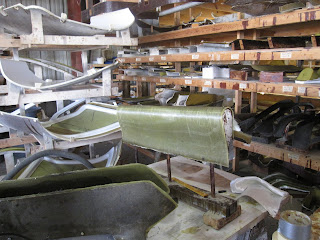
I have finally been able to fly my own plane at my own airport as I've been dreaming of doing for so long- and it was GREAT! Here is how it went.
Velocity Chief Pilot John Abraham called midweek last week to advise that the plane was working well and all the hours were flown off. I couldn't afford to take the time off from work to go down to Sebastian and fly back with him, so we decided he would fly it up to Pennsylvania Saturday morning, give me some dual and fly home Sunday after lunch.
The very idea of being able to fly up the entire coast from Florida to Pennsylvania before lunch takes some getting used to. (and I can't wait to get used to it)
I watched John's progress on FlightAware.com. As you will see from this screen shot, he averaged better than 190 knots despite winds and bad bumps. Impressive.
When the ETA got to 30 minutes, I drove over to the airport, walked out to the runway and started looking to the South into the haze, trying to spot the plane.
______________________________________________________________

.....then there it was. It looks different than the other traffic and you can tell the sound of a Velocity from other aircraft.
_______________________________________________________________

It looks good. I direct John over to transient parking and run over to say hello.
___________________________________________________________

I'm thrilled that my plane is back, but it's really hot, John's had a long flight and it's lunch time, so we tie her down and head back to the house for lunch. I keep looking back as we walk away- I finally have a working airplane! It looks cool and drew curious pilots within minutes.
____________________________________________________________

Back to the airport to get some dual before dinner. I really enjoyed this. The plane pushes me back in the seat on the first takeoff, we rotate and seem to climb like a fighter plane. This is what I've been dreaming of and is a real contrast to the months practicing here in an Arrow. We fly around just getting comfortable with the handling and avionics then shoot some landings. I manage not to terrify John and actually do pretty well. Time to button her up for the night, then a little more work tomorrow.
_____________________________________________________________

Saturday night and it's finally time to take a deep breath and relax. I can fly, do simple navigation with the GRT's and make a respectable landing holding off the nose gear and everything.
_____________________________________________________________

Sunday morning and off to the airport early. I need to land a lot shorter if I'm going to put it into my 2,200 foot home field.
John uses Google Earth to measure the distance between two taxiway turn offs which are 1,800 feet apart. I need to land after the first and come to a complete stop before the second. We've only got 2 hours to get this down and get over to Smoketown, then get him to the airport in Philadelphia.
I made it a few times and missed it a few times. I need more practice and we are out of time. We decide to swap seats and see if John can do it.
Of course, John was able to put her down and stop in less than half the runway, probably about 1,100 feet. I can't do that at this point.
Here she is safely back in my hangar at Smoketown at last. The blue tape all over the plane marks the little fixes I need to do before flying again, such as reinforcing the NACA inlets, fairing in the rudder/wing junction and getting rid of the popsicle stick spacers, etc. Then, I'll fly it over to Chester County and spend a few days practicing short landings before bringing it back solo.
I'm currently in a situation with the paint shop about trying to get the paint work done. I'm trying not to get put off too far due to missing my slot due to the damage and trip to Sebastian for repairs. It could get painted as soon as next week or as far away as January. You can guess which I'm pushing for. If they can't or won't take me in, I'll look for another shop, but I'd prefer not to as this one does really nice work.
Oshkosh looks hopeless at this point. I just don't have enough time to get comfortable enough for an 800 mile solo trip yet. I'll probably just go commercial. I'm going to shoot for the big canard fly in at Rough River as her unveiling, hopefully in final paint.
__________________________________________________________
Here is a quick video of John's initial landing at Chester County.
More to come next week. Either paint or flying - we'll see.
____________________________________________________________





